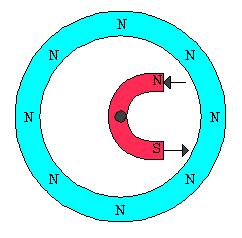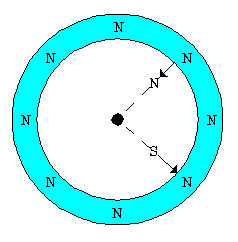The Even Simpler Magnetic Motor
 This one was a cheat. The deception lies in the picture, in psychology, and
in the way we described it:
This one was a cheat. The deception lies in the picture, in psychology, and
in the way we described it:
Clearly the N end of the horseshoe magnet will be repelled by being in such close proximity to the outer magnet's North end. Likewise, the S end of the horseshoe magnet will be attracted to the outer magnet's North end. We supply helpful arrows to show the directions of these two forces.So the horseshoe magnet will experience a counterclockwise torque, which will be the same for any position, and therefore sustain its motion.
 Well, not so clearly. Those arrows were anything but "helpful".
The horseshoe magnet is a common visual icon, and
many people think that somehow such a magnet attracts objects preferentially
straight in front of its ends. Road Runner cartoons illustrate that concept.
We have shown the force arrows in the diagram to
reinforce that (wrong) interpretation. To a first approximation magnets
with two poles behave as if the poles were nearly localized, and what lies
between the poles doesn't much affect their attraction to other objects.
This could as well have been a short, straight magnet, offset from the axle.
We show it here with only the poles. Now we see that since the outer N
pole is symmetric and of uniform strength all around the circle, the
vector sum of all forces it exerts on the horseshoe magnet's N pole is
(by symmetry argument) aimed toward the axle. It exerts no torque on the
horseshoe magnet. The same argument holds for the horeshoe magnet's S pole.
Nothing will move.
Well, not so clearly. Those arrows were anything but "helpful".
The horseshoe magnet is a common visual icon, and
many people think that somehow such a magnet attracts objects preferentially
straight in front of its ends. Road Runner cartoons illustrate that concept.
We have shown the force arrows in the diagram to
reinforce that (wrong) interpretation. To a first approximation magnets
with two poles behave as if the poles were nearly localized, and what lies
between the poles doesn't much affect their attraction to other objects.
This could as well have been a short, straight magnet, offset from the axle.
We show it here with only the poles. Now we see that since the outer N
pole is symmetric and of uniform strength all around the circle, the
vector sum of all forces it exerts on the horseshoe magnet's N pole is
(by symmetry argument) aimed toward the axle. It exerts no torque on the
horseshoe magnet. The same argument holds for the horeshoe magnet's S pole.
Nothing will move.The 1923 silent film It's a Gift starring comedian Snub Pollard illustrates these common misconceptions about magnets in a hilarious way.
The rest of the story...
Many of the analyses and "answers" on my web page are implicit invitations to readers to supply additional, or simpler reasons why the devices don't work. In this case, I've now [2010] been waiting three years for someone to point out what I left unsaid above. No one has. It would go something like this (pictures may come soon):
The uniform ring of North poles around any of these motors is a non-starter. No matter how you apply a magnetic field to such a ring, it will not turn continually. If you could make a magnetic shield that allowed no field lines to pass through it, it would necessarily distort the shape and shift the positions of the field lines. But the lines would still be closed paths from N pole to S pole. Where they cross the ring of N poles they exert forces on those magnets that depend on their direction. To find the net force on the ring, you must integrate the component of these forces tangent to the ring, doing a line integral all the way around the ring. Geometry ensures that when this is done, the net force around the ring is zero, no matter what the shape of the magnetic field. And if the inner magnet(s) exert zero net force on the outer ring, the outer ring must exert zero net force on the inner magnet(s), from Newton's third law. The same goes for torques.
In the 19th century, the mathematician Gauss (and others) proved these things mathematically.
This result is to be expected from Stevin's principle. If we held the inner magnet(s) stationary and left the outer ring free to rotate, an imagined rotation of that ring through any angle leaves it in a configuration identical to what it was before. Therefore it will not rotate.
I have another such fake motor in my paper files. I should make it into a CAD picture. Imagine the outer ring of N poles. Inside is one straight bar magnet rotatable about its center, which is also the center of the outer ring. Picture it initially with its N pole up and S pole down. Now fasten a magnetic shield on the left side of the N pole and on the right side of the S pole. Naively you might then expect the straight magnet must rotate counterclockwise. But if you draw the altered field lines from N to S poles, you see that the result is roughly the same as if you tilted the magnet clockwise a bit. In any case, the field is still mirror-symmetric, and the net force it exerts on the outer ring is zero. That's hard to visualize and hard to draw accurately. However, I suspect that with a little work one could prove that the field, altered by the shields, is nearly identical to the field of a single unshielded magnet symmetrically located within the ring of N poles, and we know that will not turn.
With or without shields, field lines are always closed paths from N to S poles. This is also true when you have any configuration of any number of magnets. This is a fundamental fact of magnetism, and is also the reason why all magnets have two poles whatever their shape. The only exception is a magnetized torus, magnetized so its field lines are closed circles entirely within the metal. Highly coercive magnetic materials can be magnetized with three localized poles, say one N and two S. But the strengths of the S poles add to the same strength as the N, and field lines still are continuous from N to S poles.
But I know what some readers may be thinking. What if you used a shield along the side of the N pole, but none on the S pole? I leave that as an exercise for the reader.
The bottom line is that however you shield the magnets, the outer ring exerts zero net torque on the inner magnet(s) and vice versa. Also, even if you could manufacture perfect shields for magnetic fields (you can't), they wouldn't improve these devices' performance at all.
Nearly all the "magnet motors" we see today on the internet are just variations of this simple "circular" design, and fail for the same reasons. Usually they try to rotate a ring or wheel of magnets by the force of a stationary one, but the roles could be reversed and the device would fail either way. Sometimes they space the magnets unevenly around the ring, or tilt them in clever ways. It doesn't help.
But some websites show videos of such wheels running! These usually are poorly (or deceptively) photographed so they don't show the details one would like to see, details that might give clues as to where the hidden source of power is. (If the inventor is clever enough to have discovered the secret of perpetual motion, why can't he make a good video?) Sometimes the energy that sustains the wheel's motion is supplied by a person holding a magnet near the wheel, and by unconscious synchronized motion of the hands feeding energy into the system. (Something like the small pushes that maintain the motion of a child on a swing.) Sometimes the deception is deliberately hidden. But whenever you see a device of this kind seemingly turning on its own power, you can be sure that the power that keeps it turning is not supplied by the device itself. And you can be sure that it wouldn't survive testing by knowledgable engineers or physicists. Finally, you can be confident it will never have any impact on our energy problems.
Footnote.
If the previous puzzle was "The Simplest Magnetic Motor", how can this one be "The Even Simpler Magnetic Motor"?Return to The Museum's Annex.